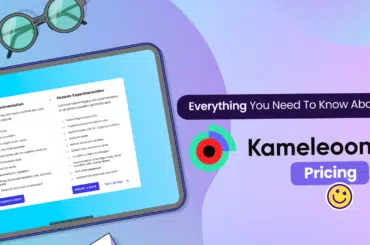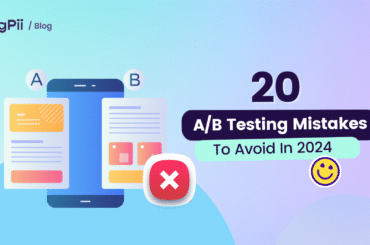If you do a quick Google search about A/B testing product pages, you will see hundreds of blog posts that talk about this exact topic.
Some articles talk about mistakes you should avoid when A/B testing on product pages. Some talk about the A/B testing ideas on product pages.
All these articles are important, but in this article, I will do you one better – and give you interesting insights from a pro who has been doing this for over a decade.
I reached out to Rishi Rawat, aka “The Shopify Product Page Guy,” Founder and CEO of Frictionless Commerce, to talk about A/B testing on product pages. Also, worth mentioning that Rishi uses buyer psychology to optimize conversion rates.
He told me a dozen things that most people miss when it comes to A/B testing product pages. You will definitely find one or two insights in this article that you didn’t know.
With that said, now, let’s delve in!
Why Should You A/B Test Your Product Pages?
I had a conversation earlier with a friend who owns an online e-commerce store about the importance of A/B testing websites, especially e-commerce.
- My friend: “How do I make my website visitors decide that my products are the right fit for them?”
- Me: Well, start with A/B testing your product pages.
- “Why? I want immediate actions; best practices. I don’t want to waste time”
- Well, what works for one website, doesn’t work for another.
And I started listing out to him what I learned so far from working at FigPii.
A/B testing helps in:
- Making it easy for visitors in finding the information that they need in order for them to accomplish the task I want them to do.
For example, the Q&A area on the products page is a great way to inform visitors more about your products. That’s why here, for this client, we moved this section to the top of the page under one of the tabs.
- Figuring out the visitors’ FUDs (fears, uncertainties, and doubts) about certain products.
For example, social proof increases trust and credibility. That’s why here, for this website that sells dancing lessons videos, we moved the social proof up to the top of the page to make sure that was the first element visitors saw.
- Finding out what distracts them on your PDP so you can remove/replace it.
For example, on this website, which is a home & lifestyle accessories brand, visitors were abandoning the checkout page upon arriving at the checkout’s first step.
One element that gave us pause was the prominent “apply promo code.” Our hypothesis was that visitors would see it and abandon “search” for a promo code across the web, never returning.
That’s why we designed the promo code field to be subtle in order not to distract the customers.
- Enhancing visitors’ trust in your products.
For example, for this brand that sells reading glasses online, the benefits of the brand weren’t emphasized and they were added in one line under ‘our promise.’
That’s why we emphasized them separately.
Now, How to Set Up Your A/B Tests on Product Pages?
On FigPii, launching A/B tests is pretty simple.
Once you log in to FigPii’s dashboard, you will find the A/B testing tool icon on your right, click on it.
Then, click on “create a new experiment.”
- The first step will be to name your experiment,
- Then, you need to choose the kind of experiment you want to launch. Either “A/B test” or a “split test.”
Split testing helps if you have a single page and you already have the new design implemented on Shopify itself, then this is a good option for you.
But, if you don’t have the new design implemented anywhere, then it is better to run an A/B test.
With split tests, we don’t handle the design of the new variation, those are handled internally on the website itself.
All we handle is splitting the traffic between the different variations
But with the A/B test, you can find all the tools in the next step “page targeting” to edit the page.
- In page targeting, you can either run the experiment on a specific page, or on multiple pages.
To understand how targeting works, check the knowledge base below:
How Do I Target Specific URLs When Running An A/B Test?
- Next, you need to choose which device you want the test to be on; desktop, mobile, or both.
And, you need to choose the visitor type: new, returning, or all of them.
- Then, in this step, you need to add your variation.
Here, you can either use the built-in FigPii visual page editor to implement your changes and ideas on the website.
Or, if you don’t want to use the visual editor and have a developer on your team, you can use CSS and javascript.
- After you create your variations, you need to choose your goals.
For the goals of the test, the main goal or the micro goal is “order confirmation.”
It represents how many products you sold. The test measures the impact the test has on your revenue. Also, it measures what percentage of visitors who have converted to the website.
Also, you have additional goals or macro goals, which you might want to keep an eye on them and see the impact of the test on them.
These goals can be: product visits, collection visits, add to cart, cart visits, and checkout.
- The last step is to save and then launch your test.
As for Rishi, when he starts testing on product pages, he likes to think of concepts that work for both mobile and desktop. He aims to target both devices at the start of the project.
How?
Rishi says:
I think the right way to start an A/B test on PDPs is to ask yourself “what are the common elements that I can extract value from that will apply to both devices?”.
How Often Should You A/B Test on Product Pages?
Rishi believes that it depends on what kind of business you are dealing with.
However, he talked about a very important point, which is organic traffic vs. paid traffic (advertising).
He says:
12 to 15 years ago, most websites got most of their traffic organically. However, the thing with organic traffic is that visitors first navigate to some inner page, read a content piece, then go to the homepage, followed by a category page. In this case, you have to think about A/B testing this whole experience.
But nowadays, with the increasing number of brands relying primarily on advertising mechanisms to acquire customers, they are being driven to a very specific part of the funnel.
Rishi gives an example saying:
Take a look at Google Shopping. Google Shopping by default connects your product feed to a product page. So, when people discover a website, they do by landing on a specific page.
Which in this case is the product page.
However, that doesn’t mean that product pages are the point of entry for all paid traffic, but according to Rishi, at least 40%, it is.
Rishi mentioned a very interesting insight he found. According to user studies, heat maps, and session recordings:
When shoppers first land on a website, even if they went to a landing page that isn’t a product page, they navigate to product pages very quickly and they come to a halt.
So, what I learned from Rishi about this point is that there is no specific amount of times you should A/B test your product page. Whenever there is room for improvement, whenever it needs to be optimized more, you A/B test.
As PDPs are the point where your customers are in or out, purchasing or bolting out.
What to A/B Test on Your Product Pages?
Among many variables, there are 4 variables for the A/B test on PDPs that Rishi talked about.
- Price.
- Product images.
- Customer reviews.
- Product descriptions.
However, Rishi has a slightly different opinion when it comes to the first 3 variables and why he prefers the last one: product description.
He says:
- For price:
When it comes to price, as a consultant, I can’t adjust your price. But even as a brand, you shouldn’t adjust your price because it is a race to the bottom.
- For customer reviews:
On the surface, they are very useful because they are considered as social proof. However, the downside is that the most recent reviews can have a huge effect on the purchase intent of the shopper.
For example, if you have 5K positive reviews, but the last recent reviews were bad, as a shopper seeing these recent reviews will impact my buying decision.
- For product images:
Product photos are in our control, however, it is very expensive to do a photo shoot.
- For product descriptions:
I like to focus on a copy because it is so light that the user won’t notice if you switch it a bit.
For example, when a consumer is buying a product they never bought before or a brand they never tried, the description is the only thing that explains to them what is this product and what it does.
Another example Rishi mentioned, is when an ecommerce store has a product that drives say about 30% of its sales, the key to keeping it going and increasing it, even more, is the description.
He also mentioned a solution to a common problem that happens sometimes while A/B testing product description, he says:
There are situations where you work for a brand that has hundreds of products, however, none of them drive enough revenue. So, in this scenario, it is difficult to write descriptions for hundreds of products. My advice is to still focus on the description itself, but also focus on a global element within it. This element can be adding a call to action that says “why we are different?”.
The point here is that brands focus on describing what that product does. But as a consumer, before I am ready to listen to what your product does, I need to know if I can trust you as a brand. So, it’s very important to help the shopper understand what is special about this brand.
What Not to Test on Your Product Pages?
When asked this question, Rishi immediately said “I’ll never A/B test a gimmick.”
He explained further by saying:
For example, when visitors click on “add to cart” on the product page, then find out that a few paid accessories were automatically added to the cart after checking out. As a shopper, I am on a product page and clicking “add to cart,” my expectation is that this is the only product I am buying. So, those kinds of gimmicks I’ll never test.
This point is very important because such gimmicks will increase your customers’ FUDs, if not ruining the trust you are trying to build with them or already built completely.
Also, Khalid Saleh, FigPii & Invesp co-founder, mentioned a fatal mistake while A/B testing on product pages:
What works for one website, doesn’t always work for another.
He says that even with two websites working in the same space, you will find that not the same things work for them.
They have different customers with different mindsets.
Khalid adds:
Be careful of copying what others do. You can get inspired and modify based on what your competitors are doing, but you shouldn’t copy.
Metrics to Focus On While Optimizing Product Pages
A while ago, Khalid mentioned 4 metrics used at Invesp that are crucial when optimizing PDPs:
- Product pages effectiveness rate
This metric measures how good your product page is in persuading visitors to click on the “add to cart button.”
PPER = The number of clicks on the “add to cart” button / The number of sessions to the product pages.
- Bounce rate
This metric measures the trust signals and price competitiveness of your product pages.
PDP Bounce rate is % of visitors who land on your product pages from an external source and leave the site without navigating to a second page.
- Conversion rate
This metric measures how good your product page is in persuading visitors to place an order.
PDP CR = The number of conversions / The number of sessions to the product pages.
- Exit rate
This metric helps you measure the product page’s ability to persuade visitors to stay on the site.
PDP exit rate is % of visitors who land on your product pages from external and internal sources and leave the site from that page.
Takeaways
Now you know that A/B testing your product pages helps in making your users’ buying experience more smooth, eliminating their FUDs, and maintaining their trust in order to make them flow easily through the funnel.
You also learned how to set up your A/B tests on PDPs and that there aren’t a specific number of tests you need to launch in order to optimize your pages.
Most importantly, you now know all about the elements to A/B test on your PDPs, what you definitely shouldn’t test, and the metrics to focus on.



